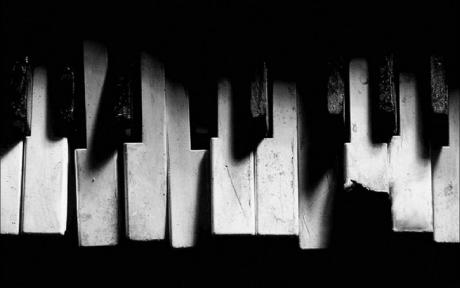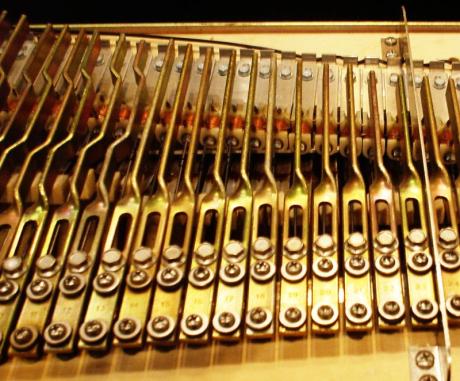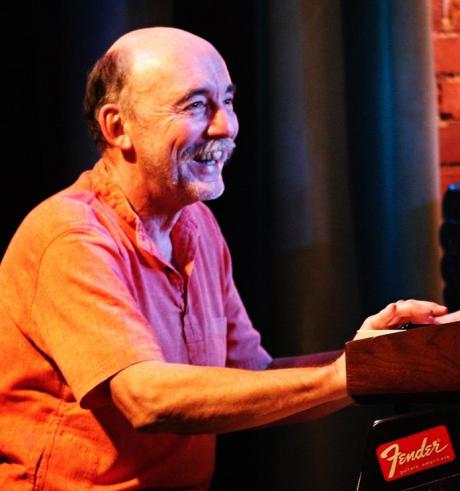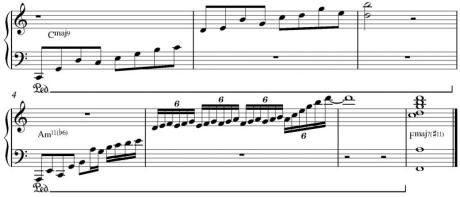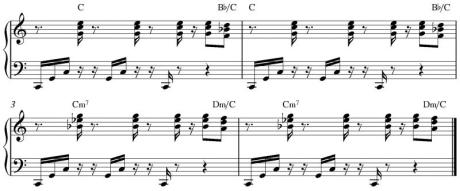Rockové klávesy XXI - workshop
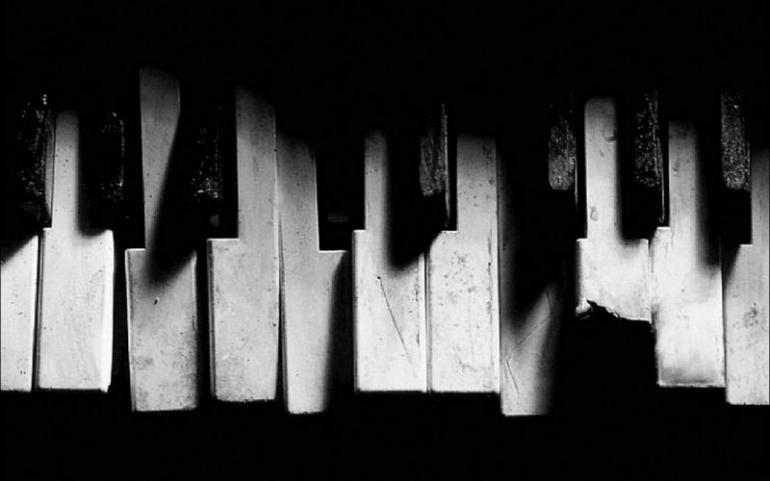
Ne, to není omyl. Nový díl seriálu jsme neponechali v angličtině omylem. Došlo nám ale, že máme jedinečnou příležitost naplnit jednu z hlavních rolí Muzikusu - roli vzdělávací. Ne, naší ambicí není naučit vás anglicky. Od toho jsou kurzy, učebnice a slovníky. Jenže zde je právě kámen úrazu - můžete mít slušnou znalost obecné angličtiny a po ruce k tomu nejlepší slovník, přesto byste ale textům v tomto seriálu nemuseli rozumět zas až tak dobře. Některé výrazy, které jsou vám buď známé nebo si je snadno najdete ve slovníku, jsou zde totiž používány v poněkud „exotických“ významech hudebního žargonu. A právě v něm bychom vás rádi vzdělali. Každý z následujících dílů bude proto doplněn glosářem pojmů, u kterých budeme mít pocit, že vyžadují vysvětlení. Bude se jednat především o slova či fráze, u kterých je vám slovník v podstatě k ničemu (pokud se nejedná o specializovaný slovník hudební terminologie). Ty ostatní si dokážete dohledat sami. A pokud vám text ani po použití slovníku nebude dávat smysl, pošlete nám e-mail s konkrétními výrazy, které byste potřebovali vysvětlit. My se je pokusíme zařadit do některého z následujících dílů. Mělo by se však vždy jednat o hudební termíny - od výuky obecné angličtiny jsou tu přeci jen jiné publikace. Doufáme tedy, že pro vás bude četba s každým dílem snazší a že vám pomůžeme proniknout do fascinujícího světa anglické hudební hantýrky!
Petr Štika a Michal Snížek
Rhodes in Depth
In many of the articles I’ve written over the last year or so, I have spoken very much about organs and analog/digital keyboards, but not so much about electric piano. For the next few months, I would like to focus on the Rhodes electric piano. We will take a close look at the history of Fender Rhodes and some important Czech keyboardists who have used the instrument in interesting ways. The Fender Rhodes electric piano was invented by Harold Rhodes and was given to soldiers returning from the front line to bolster there spirits and help them cope with mental health issues like shell shock. Harold Rhodes worked as a piano teacher and in 1942, like many men his age, found himself in the Army. Because of his experience he was asked to develop a keyboard teaching program for the soldiers with a very limited budget. The first Rhodes prototypes were made from surplus army parts. The instrument was a huge hit with the top brass (slang we use for top military personnel). Like a piano, the sound is created when a key triggers a hammer. The difference from piano is that the hammers strike thin metal rods of varied length, connected to tonebars resembling tuning forks. There is a little spring on the metal rod that can be moved to adjust the pitch of each note. The sound created is softer and more bell like than a piano and was thought to soothe the nerves of the exhausted GI’s (means soldier; I’m not sure if you have this term).
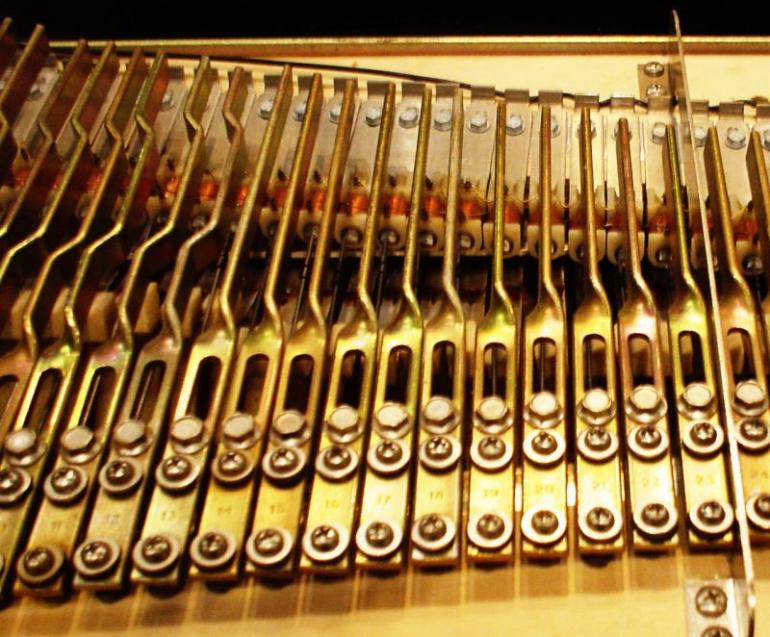
Image 2 has a very detailed diagram of the key mechanism of a Fender Rhodes.
In 1959, Rhodes went into business with Leo Fender for help with production of what was then called The Pre-Piano. Fender liked the idea, but thought a shorter bass register keyboard would be the best package for the new technology. The first Fender piano product was released to the general public as the Fender Piano Bass. This half size version of the instrument was popularized by Ray Manzarek in the Doors, It wasn’t until 1965 when the company was sold to CBS that the 73 note model with attached speaker appeared on the market. Many Rhodes electric pianos were manufactured in the early 70s as artists became more and more intrigued with it’s sound. Later models would follow; 88 key versions, suitcase models that were more compact, and the later MK series which featured improvements in the hammers and tone harp. The Rhodes was often used with effects. Some models had a great sounding washy tremolo with controls for the rate and amount of the effect. Check out Herbie Hancock’s Butterfly to hear this sound: www.youtube.com/watch?v=knbmKDUYDXc
Effect pedals also sound great on Rhodes. One great example is the MXR Phase 90. The Billy Joel classic Just the Way You Are has this sound:
Of the many Czech keyboard artists to use this great instrument, The first to come to my mind is Martin Kratochvil. I’ve had lots of opportunities to hear his great band, Jazz Q, because of my many years of playing with Laco Deczi and my close personal relationship to all members of the modern version of the group. In the early 70s Czech flutist Jiri Stivin also played with the group. Martin is a very dynamic individual who in addition to playing keyboards, is an incredible businessman and the founder of the Czech record label, BontonOne of my favorite Jazz Q tunes is The Wizard (Čaroděj) from the 1974 album Symbiosis. Check out the great Rhodes intro:
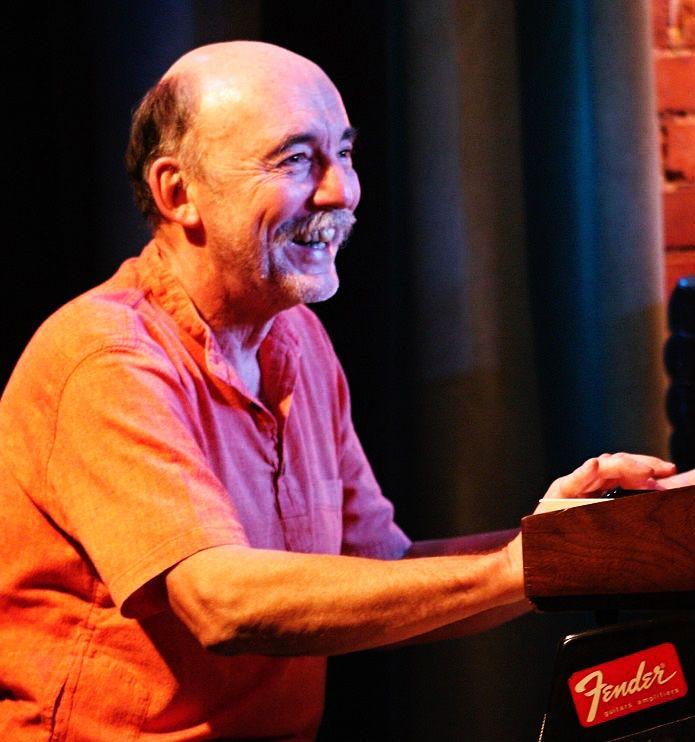
Ex. 1
In his intro, Kratochvil plays some beautiful arpeggios that he sustains with with the sustain pedal. There is also a delay effect and gentle tremolo which we will use in our Example 1. Example 1 is not an exact transcription because of copy write restrictions, so I have come up with a few bars to help work some of these concepts into your own playing. Let’s look at Bar 1. Just like Martin, we start with a bass note, in this case C, that is held in the pedal as we add notes on top of the root. Notes are added freely from the C Maj 9 tonality; a Major 7th on Beat 4 of Bar 1 and Beat 2 of Bar 2, a 9th on Beat 2 of Bar 1. The other notes are chord tones. Because all the notes are sustained in the pedal, the complete harmony of the chord rings out. In bar 3, a 9th and a M7 are struck together to put a point on the phrase. You can use very many variations in the order of notes to get the same effect, so don’t be overly concerned with which notes come first, just try to get the vibe. Bar 4 has a new chord, so we lift the pedal briefly for the Am11♭/6 chord. Bar 4 starts in a similar way as Bar 1 but soon morphs into a sextuplet motif that repeats a step higher each time before reaching on the 11th in bar 6. The last bar finishes on a nice FMaj7#/11 voicing which has many of the notes we have played in the right hand arpeggios, this time with an “F” in the bass.

Ex. 2
The inspiration for Ex 2 also comes from The Wizard. This exercise is meant to emulate Kratochvil’s Rhodes groove as the band comes in on the tune. I’ve added a few bass notes here just so we can see how the chords function against the root. I also give a minor version in Bars 2-4 so you can use the idea no matter what the tonality is. On your own, transpose this exercise into 12 keys so you can play this type of groove in every key. The right hand part in bars 1-2 moves from the tonic chord to the flat 7 triad (B♭) on beat 4+. This triad in combination with the C triad gives the impression of a C7sus4 chord which has a great, open, sound for vamps. Notice also how the right hand shapes enter when the syncopated bass rests. When playing with a bassist and drummer, try to place your chords in the “cracks” of the groove; places that the other instruments leave open. Bars 3-4 have a minor version of this idea. This time we alternate between an E♭ and Dm triads over the C bass. Alternating the right hand triads gives gentle melodic motion to the accompaniment pattern and is more interesting than just staying on one voicing. This exercise also adds a little chorus effect which also sounds great on this instrumentNext month we will continue studying this great instrument and will take a look at a few more Czech Rhodes players and how they approached the instrument.
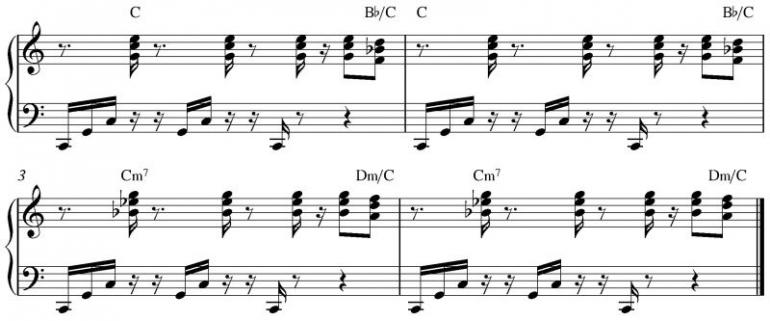
Fráze a hudební termíny:
Tuning fork: Ladička „starého typu“, tedy kovové „vidličky“, které rozezníme úderem a naladíme podle nich nástroj.
Harp: Běžně se takto označuje harfa, slangově také foukací harmonika. Zde to ale znamená něco jiného - „hřeben“ plíšků, do kterých v případě elektrického piana udeří kladívko a utvoří tak tón.
Rate: V případě efektů (obzvláště modulačních) znamená tento pojem „rychlost“ či „frekvenci“. Pozor, mimo hudební kontext má slovo mnoho jiných významů („míra“ apod.)!
Arpeggio: Mezinárodní termín, který zdánlivě není třeba vysvětlovat. Ale pozor, dle mé zkušenosti si pod ním mnoho Čechů představuje pouze velmi rychle hrané rozklady (u kytary např. „sweep picking“), zatímco v angličtině (a v klasické hudební terminologii) se používá pro rozklady akordů obecně. Detail, ale důležitý...
Vamp: Nepřeložitelný termín, používaný především jazzovými hudebníky. Jedná se o zpravidla improvizovaný doprovod - opakující se motiv, který se buď „motá“ kolem jednoho akordu nebo obsahuje několik jednoduchých akordů či tónů. Jedná se o částečné synonymum ke slovu „riff“ (ale na rozdíl od klasického riffu se může obměňovat). Používá se především jako doprovod pro sólo.
Root: Přestože ve slovníku najdete překlad „kořen“, v hudební terminologii znamená „tóniku akordu“, tedy základní tón (např. v C dur to bude tón c).
Sustain pedal: Někdy se používá synonymní výraz „damper“ a popisuje všem dobře známý pedál na prodlužování tónu u klávesových nástrojů.
Triad: Kvintakord, tedy akord založený na souzvuku tóniky, tercie a kvinty. Tercie může být malá (v mollovém akordu) či velká (v durovém), zatímco kvinta může být čistá, zmenšená či zvětšená.
Pattern: Opakující se hudební motiv, např. sled akordů či rytmická figura.
Voicing: Stejný akord lze zahrát několika způsoby a právě pojem „voicing“ znamená jeden konkrétní z těchto způsobů. Částečně se překrývá s pojmem „obrat“, je však volnější („obrat“ se zpravidla překládá jako „chord inversion“). Základní varianta mívá tóniku nejníže, ale možností (voicings) je mnoho...
Cracks of the groove: Pomlky neboli „štěrbiny“ v rytmické figuře, kam můžeme umísťovat příznaky, aniž bychom „bojovali o místo“ s ostatními nástroji.
